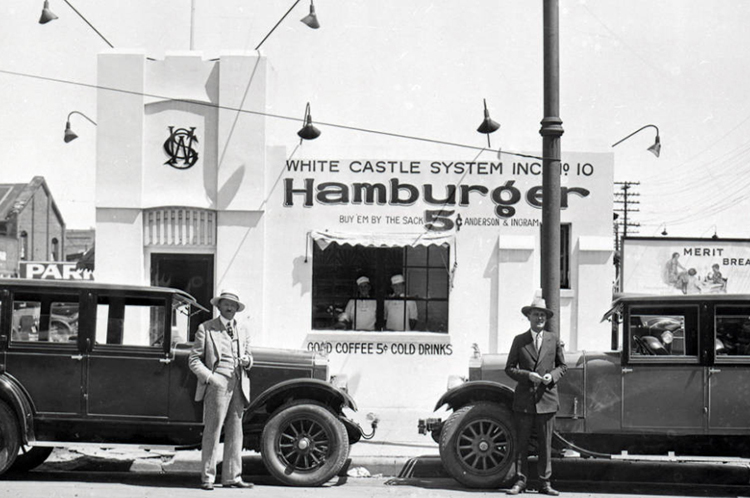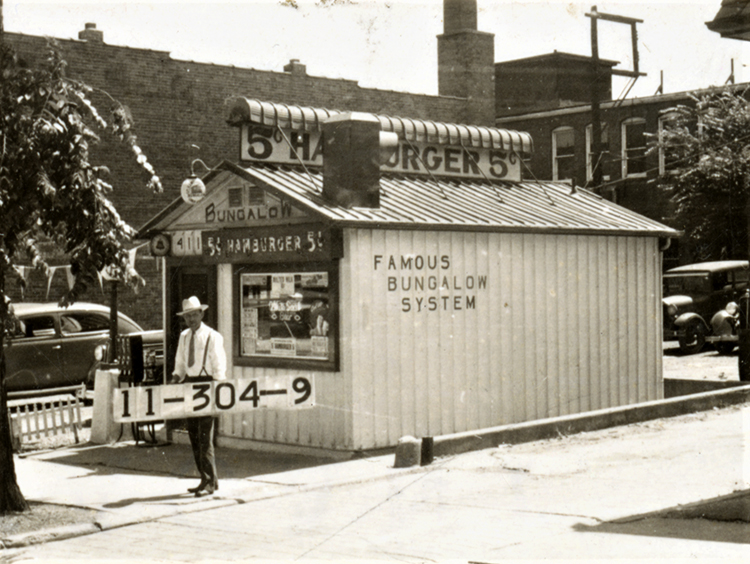KCQ serves up a history of early KC hamburger stands
While the hot dog is considered quintessential cuisine for the July Fourth holiday, the hamburger is undeniably king among American eats. It is a menu staple at restaurants throughout the U.S., not to mention the backyards and ballparks in which countless grilled patties are served up and consumed.
Kansas City has its own juicy burger history — the focus of this installment of What’s Your KCQ?, an ongoing series produced by the Kansas City Public Library and The Kansas City Star.
A reader recently perused the Library’s 1940 Tax Assessment Photograph Collection, a photographic survey of Kansas City buildings and residences, and noticed numerous hamburger stands around the downtown area. Town Topic and White Castle were two familiar names, but Bungalow, Eat-Moore, Happy Hollow, and many others were not.

The reader reached out to KCQ, wondering why the businesses looked so similar — all housed in tiny, white buildings and selling 5-cent hamburgers. Was there a connection?

The Hamburger’s Humble Origins
The modern hamburger — a fried or grilled beef patty, served on a bun and garnished with any number of condiments and accoutrements — has evolved since 19th century German immigrants introduced the U.S. to frikadellen, commonly known as “Hamburg steak.” It was a simple and inexpensive dish of seasoned meat patties, pan-fried, and often served with potatoes.

The originator of the burger-on-a-bun concept is uncertain, with food purveyors in several states staking claim to the honor. Some sources point to the hamburger sandwich debuting at the 1904 St. Louis World’s Fair.
Regardless of who first served the hamburger, it didn’t immediately take off with the eating public. A novel published in 1906 was largely to blame.
Upton Sinclair’s The Jungle shined a light on the dangerous working conditions endured by American meatpackers. The accompanying descriptions of unsanitary practices and contaminated meat turned stomachs and turned off the appetite for ground beef.
As a result, the hamburger was looked down upon as low-class street food.

But in 1921, a short-order cook and real estate agent in Wichita, Kansas, would reinvent the traditional hamburger stand and start a fast-food craze that would spread rapidly to other Midwestern cities — including Kansas City.
White Castle System
Kansas-born Walt Anderson worked a string of low-paying jobs throughout the Midwest in the early 1900s. While a fry cook in Wichita, he began experimenting with different cuts of meat and bun types. His version of a flattened meatball — a thin beef patty, seared on both sides with onions and served on a small bun — became a customer favorite.
In 1916, Anderson borrowed $60 and converted a shoe repair shop into a three-stool lunch counter. His signature menu item was advertised on a sign out front: “Hamburgers 5₵.”

To ease public concern about meat safety, Anderson ground his own beef behind the counter and cooked the patties in view of his customers. By 1920, he operated four hamburger stands in Wichita and urged his customers to “Buy ’em by the Sack” — a half-dozen burgers per bag.
The following year, Anderson partnered with entrepreneur Billy Ingram to open the first White Castle restaurant in Wichita. The name was chosen to convey cleanliness and quality, with “white” signifying purity and “castle” denoting stability and permanence.
The building’s white-washed exterior and whimsical castle motif set it apart from competing hamburger stands, which were often little more than shacks. Gleaming countertops and food preparation areas further reinforced the commitment to cleanliness.

The strategy succeeded in changing public perception of the hamburger as questionable “fair food” and in attracting more middle-class consumers. The White Castle System of Eating Houses, the incorporated name of the company, spread to other Midwestern cities, and the modern fast-food hamburger franchise was born.

White Castle’s popularity and brand recognition spawned many copycats. Operating under such names as White Crown, White Tower, and Little Kastle, these eateries often adopted White Castle’s trademark white building and architecture, and of course its 5-cent burgers. Some competitors went a step further by appropriating the “Buy ’em by the Sack” slogan.

After expanding into Omaha, Nebraska, White Castle turned its sights on the burgeoning Kansas City market. The first restaurant opened in 1924 at 13 West 19th Street. By the end of the year, there were three additional locations. The franchise continued to grow over the next decade, with the 11th Kansas City White Castle opening at 38th and Main streets in 1937.

But White Castle wasn’t the only burger franchise in town.
Bungalow System
The Bungalow Lunch Company, with its self-proclaimed “Famous Bungalow System,” had 12 locations in and around downtown Kansas City. It, too, specialized in 5-cent hamburgers served around the clock, catering to carry-out customers. Signage encouraged passersby to “Buy ’em at a Bungalow.”
The company was established in 1924 by Andrew Bixby, who according to earlier census records worked in sales. City directory listings from 1919-’23 show him employed by an adding machine company in Wichita, Kansas. Although, no connection between Bixby and Wichita-based White Castle was found, it’s likely he would have been familiar with the upstart hamburger chain, if not inspired by the concept.

Like White Castle, Bungalow restaurants were housed in small buildings just large enough for a grill, lunch counter, and a few stools, and were located in high foot traffic areas. Both franchises weathered the Depression by serving affordable fare to working-class clientele.
But there were obstacles along the way.
Running a 24-hour operation with minimal staff made Bixby’s restaurants a target for robbers during hard times. Newspaper reports from the 1930s and ’40s frequently mention robberies at various Bungalow locations. The Kansas City Times reported in 1946 that a location on East 15th Street had been held up three times in eight days and an astonishing 100 times in the past decade.

In 1935, Bixby and other local business owners made news by speaking out against a city ordinance requiring a liquor license for sales of 3.2% beer, which Bixby maintained was 15% of his business. Two years later, he was forced to temporarily shut down all operations due to a restaurant workers’ strike.
Bixby persevered, however, and reopened his restaurants. He would later serve two terms as president of the Kansas City Restaurant Association before retiring from the burger business in 1946.

White Castle had shuttered its Kansas City operations three years earlier due to labor and supply shortages following the outbreak of World War II. The franchise wouldn’t return to Kansas City until the 1980s.
Town Topic Hamburgers
One of Kansas City’s most iconic — and long-lasting — burger joints opened during the Depression era and survived the lean war years of the 1940s: Town Topic.
Two former White Castle employees, Claude Sparks and Heywood Billings, opened the first Town Topic Sandwich Shop at 2442 Broadway in 1937. The entrepreneurs were forthcoming about modeling their burger venture after their former employer. “We tried to pattern it exactly after White Castle,” Sparks told The Kansas City Star in 1984.

This included selling hamburgers for a nickel apiece, 24 hours a day, and offering coupons to entice new customers.
At a time when other hamburger operations were closing, Town Topic added a second location at 11 East Linwood Boulevard in 1939 and a third at 2021 Broadway in 1944.

While the Sparks and Billings partnership dissolved soon after, Sparks continued to grow the franchise, opening three new locations by 1955. The last shop opened in 1987 on Johnson Drive in Mission, Kansas.

Town Topic continues to sell burgers by the bagful at its historic Baltimore and Broadway locations, a vestige of the simple hamburger stands of the 1930s and ’40s.
White Castle returned to Kansas City in 1985 but pulled out of the market in 2001. Loyal fans of the franchise continue to lobby for its return and crave its signature sliders by the sack.
Note:
The WHITE CASTLE image and trademark are the exclusive property of White Castle Management Co. and are used under license. No use, reproduction, or distribution is allowed.SUBMIT A QUESTION
Do you want to ask a question for a future voting round? Kansas City Star reporters and Kansas City Public Library researchers will investigate the question and explain how we got the answer. Enter it below to get started.


